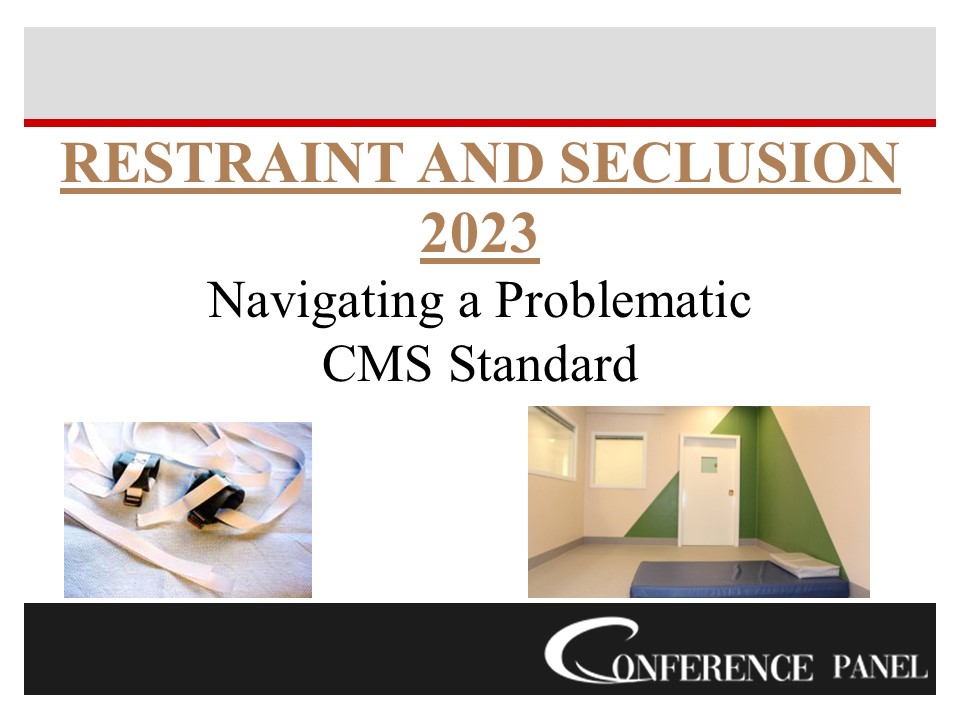CMS Hospital Restraint and Seclusion: Best Practices - PowerPoint PPT Presentation
Title:
CMS Hospital Restraint and Seclusion: Best Practices
Description:
The CMS Hospital Restraint and Seclusion Webinar aims to shed light on the pressing issues surrounding compliance in this crucial area of healthcare. By understanding the training requirements for physicians and providers, educating staff on interpretive guidelines, and aligning with both CMS and Joint Commission standards, hospitals can successfully navigate the complexities of restraint and seclusion protocols. – PowerPoint PPT presentation
Number of Views:2
Title: CMS Hospital Restraint and Seclusion: Best Practices
1
RESTRAINT AND SECLUSION2023Navigating a
Problematic CMS Standard
2
Speaker
- Laura A. Dixon, Esq.
- BS, JD, RN, CPHRM
- President, Healthcare Risk Education and
Consulting, LLC - 303-955-8104
- ldesq_at_comcast.net
- Email questions to CMS
Critical Access Hospitals
qsog_CAH_at_cms.hhs.gov. Acute
hospitals qsog_hospital_at_cms.hhs.gov.
2
2
3
Rethinking Restraints in Hospitals
- Study found 27,000 patients restrained every
- About 5 per hospital and prevalence is 50 per
1,000 patient days - 2007 Study in Journal of Nursing Scholarship, Vol
39, Issue 1, Page 30-37, Prevalence and Variation
of Physical Restraint Use in Acute Care Settings
in the US - Restraints increase the risk for delirium by
4-fold - JAMA March 20, 1996275(11)852-857,
Precipitating Factors for Delirium in
Hospitalized Elderly Patients - Restraints increase the rates of pressure ulcers,
respiratory complications and even death via
strangulation and aspiration - HHS study in 2006 found that 40 of hospitals
fail to report deaths to CMS - Hospital Reporting of Deaths Related to RS, OIG
and HHS, at http//oig.hhs.gov/oei/reports/oei-09-
04-00350.pdf
4
Why RNs Reduce Need for Restraints
- If low number of registered nurses
- Odds of using restraints were 11 and 18 higher
- Use of restraints to prevent a fall were 9 to 16
higher - RNs are better trained to find alternatives to
restraint and seclusion - Physical restraints can include belts, mittens,
vests (note most hospitals do not use), bedrails,
geriatric chairs, and other devices - It is not the number of staff present to reduce
falls but rather having adequate number of RNs
5
2022 Article Use of Restraints in Hospitals
- Study utilized three topic-based focus groups
- 19 participants from nursing, PT and medicine
- Participants noted lack of precise hospital
guidelines - Documentation often lacked the effect of
restraint on patients behavior - Restraints were described as a safety measure
- Implementation most often led by nurses
- Attitudes and experiences were main detriments
for restraint use - Experienced nurses tended to use restraints less
- Prior experience with violence ? more use
- https//www.ncbi.nlm.nih.gov/pmc/articles/PMC88590
77/pdf/NOP2-9-1311.pdf
6
Introduction to the CoPs on Restraint and
Seclusion
7
2019 Changes to RS
- Changed licensed independent practitioner to
licensed practitioner - Allows Physician Assistant to order RS in state
that held the PA was a dependent practitioner - Physician and other licensed practitioner
training requirements must be specified in the
hospital policy
8
Hospital Deficiency Data
9
Number of RS Deficiencies
Tag Number January 2023
154 Use of Restraint or Seclusion 273
159 Definition physical restraint 38
160 Definition chemical restraint 78
161 What Is/Is Not a restraint 18
162 Definition seclusion 39
164 Less Restrictive Ineffective 118
165 Type Least restrictive 89
166 Written Modification of Plan 237
167 Safe Appropriate Technique 197
168 Order Required 677
10
RS Deficiencies
Tag Number January 2023
169 Never a Standing Order 91
170 Attending Consultation 27
171 Time Limits for Restraints 140
172 Assessment in 24 Hours 16
173 Order Renewed by Policy 77
174 D/C RS Earliest Possible Time 170
175 Trained Staff Monitor Patient 318
176 Training Requirements in Policy 53
178 One-Hour Face-to-Face 172
179 One Hour Evaluation Elements 163
11
RS Deficiencies
Tag Number January 2023
180 State Can Be More Restrictive 3
182 RN Consultation with Attending 15
183 Continuous Monitoring for RS 4
184 Documentation 1-hour F2F 39
185 Documentation Behavior and Intervention Used 54
186 Documentation Alternatives Used 47
187 Documentation Patients Condition 37
188 Documentation Patients Response 52
194 Staff Training Required 71
196/199 Training Intervals Content 93/19
12
RS Deficiencies
Tag Number January 2023
200 Training Non-physical Intervention 36
201 Training Least Restrictive Methods 8
202 Training Safe Application RS 35
204 Training Identify RS Can Be D/Cd 3
205 Training Patient Monitoring RS 22
206 Training First Aid and CPR 94
207 Training By Qualified Trainers 6
208 Documentation of Training 56
213 Death Reporting to CMS 25
214 Death Reporting Internal Log 46 Total 3,759
13
CMS Surveyor Training Website
14
Complaint Manual
15
CMS Hospital CoPs on Restraint and Seclusion
16
SECLUSION
17
RESTRAINTSStandards and Guidelines
18
Not Covered By Rule Law Enforcement
- What
- Handcuffs
- Manacles
- Shackles
- Other chain-type restraint devices
- Not hospital staff
- Not considered safe nor appropriate interventions
- Ensure PP mention
- Who
- Non-hospital
- Employed
- Contracted law enforcement
- Purpose
- Custody
- Detention
- Public Safety
19
Restraint Chair Used by Law Enforcement
- Emergency restraint chair
- Manufacturer states used for safe transports to
hospital or court - Safely restrains a combative or self-destructive
person
20
Items to Document
- Skin integrity
- Circulation
- Respiration
- IO
- Level of supervision appropriate to meet
patients safety need
- Hygiene
- Any injuries
- Continued need for use
- Adequate justification for continued use
21
JOINT COMMISSION RESTRAINTS AND SECLUSION
22
The End Questions???
- Laura A. Dixon, Esq.
- BS, JD, RN, CPHRM
- President, Healthcare Risk Education and
Consulting, LLC - 303-955-8104
- ldesq_at_comcast.net
Register Now
22
22































